How DeepSeek Shattered Barriers and Unlocked the Crucial Gateway to AI Commercialization
![]() 02/08 2025
02/08 2025
![]() 564
564
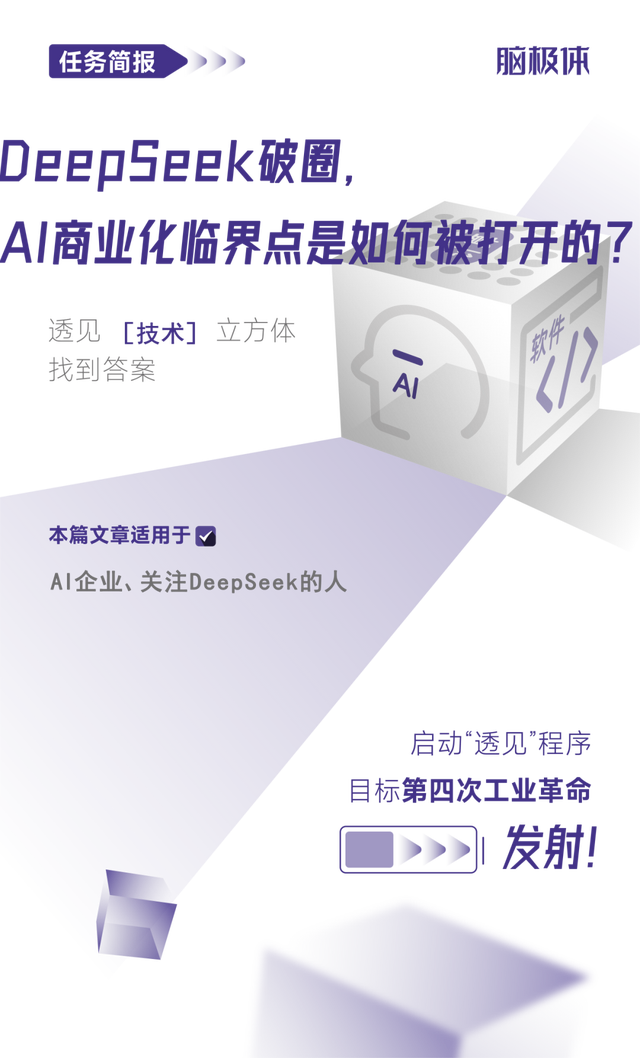
This Spring Festival holiday, DeepSeek stirred up quite a storm in Silicon Valley. While much of the conversation revolved around models and applications, a critical question remains unanswered: What pivotal breakthrough did DeepSeek's meteoric rise achieve for AI commercialization?
Understanding the context is crucial. Since ChatGPT sparked the large model trend in early 2023, numerous global models have emerged, yet there's always been a lag between AI large model commercialization and technological breakthroughs. Some models faded into obscurity post-launch, while others quietly retreated from pre-training.
DeepSeek not only showcased the technical prowess of domestic AI to the world but also revealed that the commercial vitality post-technological breakthrough is exceptionally robust. The bustling servers and active integration with cloud vendors/industry partners have fueled anticipation for the commercial future of this technological enterprise.
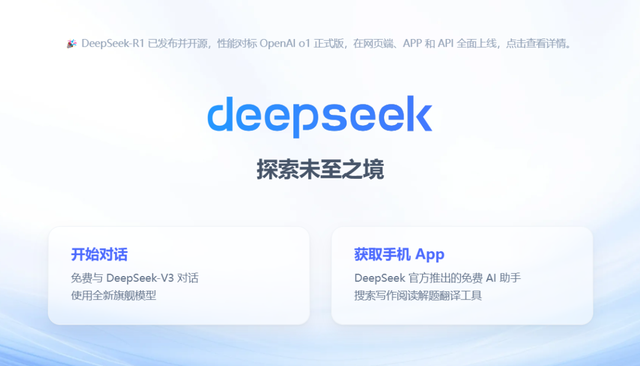
Reflecting on DeepSeek's journey of breaking barriers, a unique aspect stands out: the technological discussions surrounding DeepSeek made unprecedented strides in quality, breadth, and depth, fostering a process of technology democratization widely accessible to the public, paving the way for DeepSeek's breakthrough and opening avenues for AI commercialization.
Today, let's delve into the driving force behind DeepSeek's breakthrough and the inspiration it brings to AI commercialization.

Whether it's ChatGPT's large language model or the reasoning model represented by DeepSeek-R1, both have a high cognitive threshold. For ordinary people to grasp these high-level achievements from major corporate labs, they must navigate through sensational headlines and penetrate the information fog of AIGC fabrications to find genuine, rational, and objective sources as entry points into the technological world.
A quick review of DeepSeek's breakout journey reveals that a significant number of professional bloggers have become anchors for technology dissemination.
First, long-time AI-following technical bloggers conducted advanced technical tracking, research, and warm-ups, continuously dispelling public misconceptions about technology.
As early as mid-2024, many tech practitioners were already exchanging and discussing the potential of the DeepSeek V2 model on social platforms, and this low-profile AI startup began to demonstrate its prowess.
In December 2024, when the new DeepSeek V3 model leaked, tech blogger @Lanxi initiated a topic discussing how Chinese AI is competing with Silicon Valley, also mentioning Unitree Robotics, which made headlines during the Spring Festival Gala. Long before the public marveled at DeepSeek, these industry insiders had already perceived shifts in industrial trends.
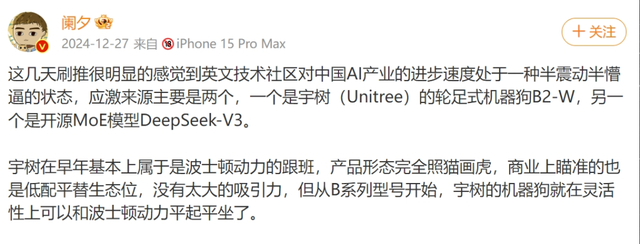
The most crucial juncture was in January 2025, when DeepSeek-V3 and R1 were open-sourced. This was a major event in the AI industry, but what does open-source mean to the general public or even society? A multitude of technical bloggers wielded the scalpel of rational analysis on open discussion platforms.
Including @Liang Bin penny, @Haixin Hyacinth, @Berkeley_You Yang, @Fly high, among others, they conducted in-depth discussions on technical papers, model architectures, and innovations, dissecting obscure technical papers in detail. The public and media began paying attention to this domestic AI innovation's unique aspects, with intense discussions on DeepSeek. Since then, DeepSeek continuously introduced new trending topics, and its popularity soared.
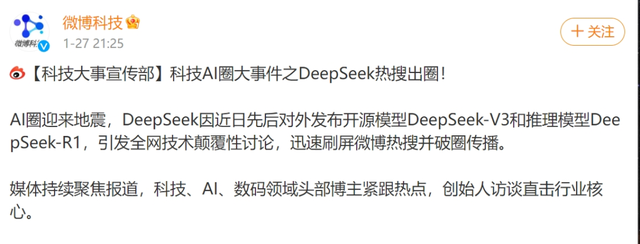
These professional bloggers are high-quality information sources for understanding AI and the first touchpoint for the vast majority of ordinary people to engage with AI. Their insightful discussions and reflections have become the primary driving force and origin for DeepSeek's breakthrough.

Before DeepSeek, many domestic models could rival overseas products but were constrained by tech companies' inertial thinking of "emphasizing R&D but overlooking marketing." Marketing methods primarily involved issuing PR announcements at model release, uploading technical documents and benchmark scores to tech communities, etc., with low discussion levels and difficulty sustaining momentum.
In contrast, DeepSeek's breakthrough is intertwined with large-scale cross-domain interactions, in addition to the model's advanced performance.
If technical bloggers wield the scalpel of thought, a broader spectrum of ordinary bloggers/influencers/KOLs hold the "DeepSeek + domain" wall-breaking machine, expanding AI application boundaries.
Some individuals have broadened the discussion on DeepSeek. Interpretations of technical papers are fundamental, and beyond that, various perspectives emerged swiftly.
For instance, many netizens marveled at DeepSeek-R1's magic but had never used a reasoning model, fearing it would be difficult to start. AI blogger @Digital Life Kazek released "DeepSeek's Prompt Tips: There Are No Tips" on New Year's Eve, alleviating ordinary people's usage concerns and adding heat to DeepSeek during the Spring Festival holiday.
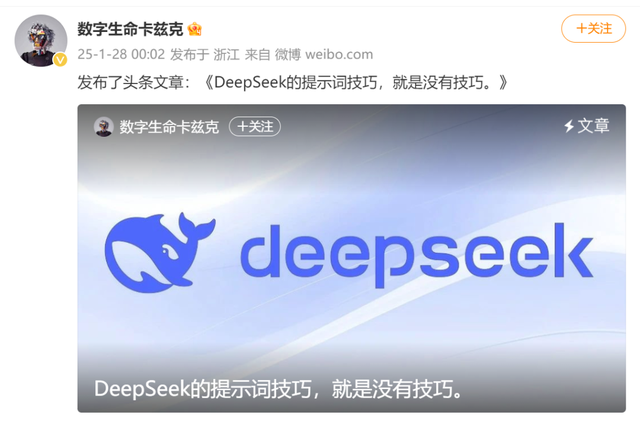
When the public wondered why DeepSeek could shock Silicon Valley this time, senior tech expert Ruan Yifeng @ruanyf shared an early internet discussion on "the power of open source overturning the AI industry landscape" through an interview with DeepSeek's founder Liang Wenfeng.

@Haixin Hyacinth, from a team management perspective, believes that DeepSeek's youthful team signifies that seniority-based ranking in the AI era will become less common...
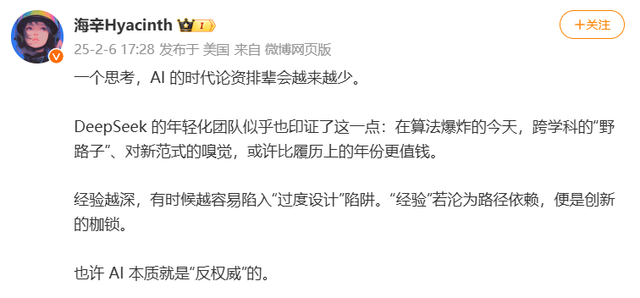
These diverse perspective discussions fully opened up and sustained DeepSeek's popularity.
These discussions further inspired bloggers from multiple industry fields to start paying attention to and discussing DeepSeek, exploring various ways to integrate DeepSeek with scenarios.
For example, screenwriter @Wang Hailin discussed the disruption AIGC based on reasoning models brings to screenplay creation; blogger @Zero gravity tile force used the analogy of "AI solving problems like an academic overachiever doing homework" to explain large model thinking chains, making reasoning models accessible to everyone, not just a theoretical concept.

Cross-domain collisions across various industry fields led to a surge of creative DeepSeek applications, becoming a new impetus for DeepSeek's breakout, driving more users from diverse fields to participate in discussions and expanding AI commercialization boundaries.

Becoming a hit is common, but sustaining traffic isn't. The ultimate test of AI commercialization lies in transforming phenomenal events into sustainable commercial momentum. Is this feasible?
In recent years, smart terminals, new energy vehicles, domestic 3A games, etc., are domestic technological breakthroughs that have created enormous commercial value. From this, we discern where technological product vitality stems:
First, it relies on people, leveraging individual IP and internet celebrity status to continuously drive traffic. Taking Xiaomi Automobile as an example, Lei Jun personally leads the charge, sharing details on personal microblogs and other social media platforms, interacting frequently with netizens, driving immense attention. It has also inspired car companies and tech enterprise founders to step from behind the scenes to the forefront, turning technological products into popular conversation topics.
Second, it relies on products. Taking the fiercely competitive mobile phone market as an example, in recent years, mobile phone manufacturers have become more down-to-earth in their marketing, prioritizing listening to advice and "giving users what they want," so that mobile phone innovation is no longer the closed-door work of product managers but a custom topic co-created with users. vivo and OPPO have both leveraged social platforms to optimize their products and achieve growth.
Third, it relies on word-of-mouth. DeepSeek's popularity has also drawn attention to scientific and technological enterprises such as Game Science behind "Black Myth: Wukong" and Unitree Robotics. Their products started as niche products praised by enthusiasts and quickly spread to the public eye through word-of-mouth on social media, winning reputation for Chinese technology globally.

It's evident that in the technology field with long cycles and heavy investments, becoming an overnight sensation is accidental, and long-term success hinges on deep cultivation. Automobile companies and mobile phone manufacturers both consider content social platforms as key brand territories, maintaining long-term, high-frequency interactions with potential users and transforming social traffic pools into fertile commercial soil.
The AI industry is no exception.
DeepSeek's popularity and breakthrough lie in breaking the overseas AI usage blockade, enabling the entire population to use advanced reasoning models, turning AI into a tool everyone talks about and uses, with over 200 trending topics.
During the Spring Festival, we witnessed numerous interactions between ordinary people and DeepSeek. Beauty bloggers used DeepSeek to customize skincare solutions; parents generated "high EQ replies" with DeepSeek in parent-child communication; surfers used DeepSeek to "sharply comment" on various news events... Various unexpected ways of engagement became moments of collision between AI technology and reality. Among the 200+ trending topics, DeepSeek evolved into an AI application experiment with nationwide participation.
In this wave of nationwide discussion and use, DeepSeek continuously attracts new users through word-of-mouth propagation, leading to a surge in user scale. On this foundation, a vast amount of data from real interactions can be obtained to optimize model product usage effects, further widening the gap with other models.
Unlike traditional marketing methods of buying traffic through bidding, DeepSeek's path to breaking out is a combination of setting trending topics for discussion—leading bloggers in technology/industry opening up discussion angles—and a large number of users participating in public testing. It gradually guides real users to join discussions, interactions, and feedback.
Saturated nationwide participation has set in motion DeepSeek's growth flywheel, becoming the biggest driving force for its breakout.
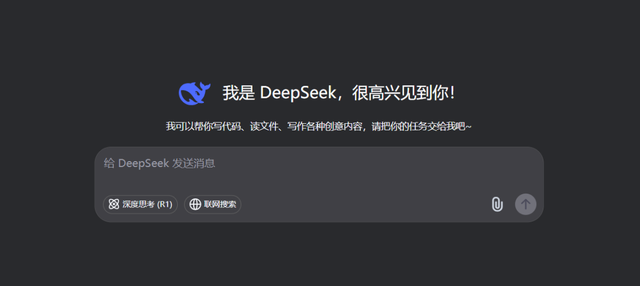
This also reminds us that democratizing AI technology for the masses is a prerequisite for commercial success.
From a technological perspective, AI differs from traditional internet applications and technological products launched in complete form. Many AI models and products need to be launched first and then find their Product-Market Fit (PMF), growing and maturing through iterative user interactions. Therefore, AI products must emphasize public participation, with at least significant participation from the target user group.
From a market competition perspective, AI products are in a fiercely competitive new user acquisition cycle, and basic models require scale effects. Therefore, competition is intense, and lacking visibility is akin to "waiting to die." AI enterprises must constantly generate public attention and discussion about technology. OpenAI's 12-day technology release at the end of last year attracted global attention through topic setting.
Previously, technical exchanges in the AI field were mostly concentrated in geek technical communities where developers gathered or in developer communities of major AI companies, with closed-door exchanges with corporate clients, lacking experience in interacting with C-end consumers on social platforms.
However, AI applications based on large models are gradually changing their marketing strategies. This batch of large model applications, represented by Doubao, Wenxiaoyan, Kimi, etc., are increasingly emphasizing C-end dissemination, with user numbers becoming an important indicator of product vitality. DeepSeek's breakthrough shattered the usage blockade of overseas reasoning models in one fell swoop, making advanced AI technology visible, talkable, and usable by the masses. This is the best example of technology democratization and the only path for AI to achieve commercial success.
Faced with the AI democratization wave sparked by DeepSeek, global AI enterprises may face a critical choice: be silently overwhelmed by the DeepSeek craze or accelerate embracing hundreds of millions of ordinary people.






